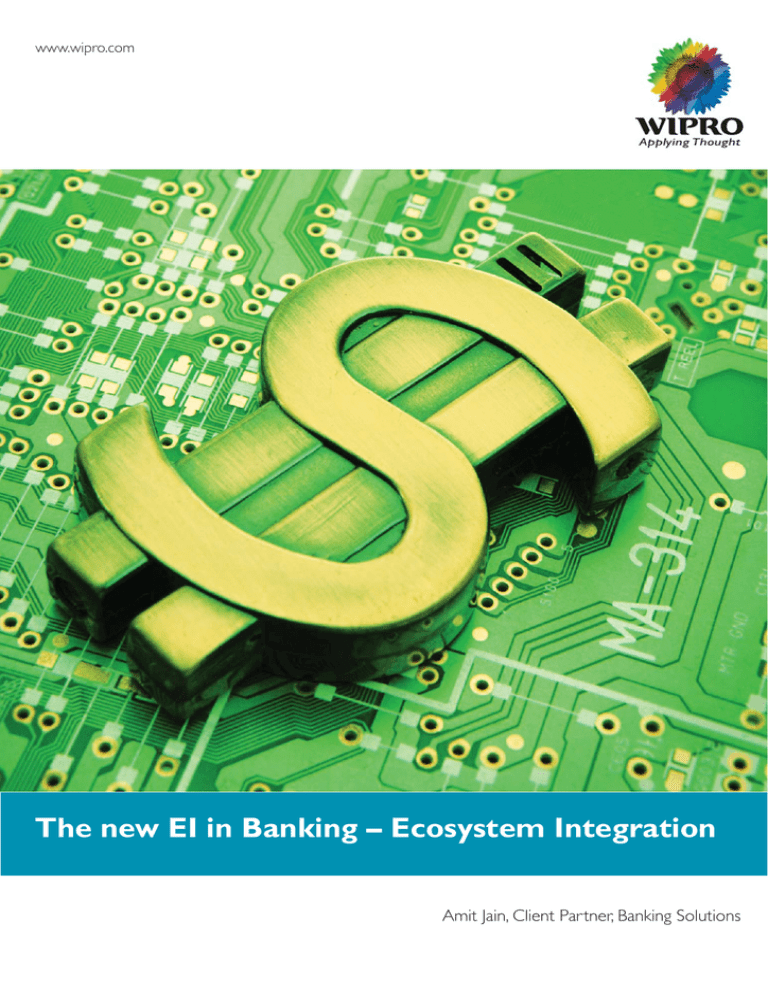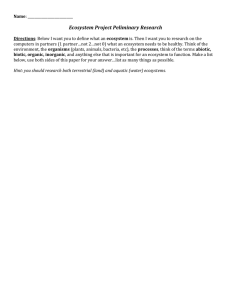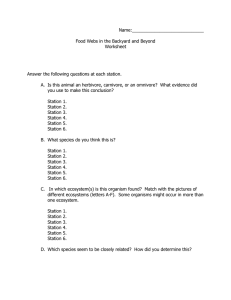
www.wipro.com
The new EI in Banking – Ecosystem Integration
Amit Jain, Client Partner, Banking Solutions
We have moved out of an era where one company competes against the other within an industry. This era is about competing ecosystems. The
entities in the ecosystems include, but are not limited to, governments, business partners, consumers, technology change agents and unknown
disruptors in the form of new security threats and market risks. Every business, and more importantly banks, needs to identify the changing face of
their immediate ecosystem and the influence on their existence. The concept of banking is morphed into a ‘network of businesses’. And this network
is changing dynamically – its DNA being influenced by an overwhelmingly large number of entities in and around its ecosystem. It is changing
emotionally, structurally, and operationally. It is time to go back to the drawing board and decide what business your bank is in.
Banking is undergoing major transformations and it is time to embrace the change at the velocity of change itself. Some of the key changes
embracing banking today are
EMOTIONAL CHANGE
Measuring ‘Trust’ and ‘Excitement’
STRUCTURAL CHANGE
Realignment of risk and reward in
the value chain
OPERATIONAL CHANGE
Need for twice the speed at twice
the traffic
Emotional change: Measuring
‘Trust’ and ‘Excitement’
executives at all banks. Non banking logos are now an integral part of
Measuring ‘Trust’ and ‘Excitement’There is a fundamental shift across the
create new forces and have led to redistribution of risk and rewards in
dimension of emotion. There is a court of public opinion that influences
the value chain.
the traditional banking value chain. New game changing partnerships
have emerged with telcos, technology providers and retailers that
the way data points are interpreted across boardrooms. Banks are
now talking of measuring the ‘fun’ element in mortgage buying or the
‘excitement’ in a branch visit, comparing it with other retail shopping, like
buying a car or visiting your favorite retail shop. Social media’s power,
post the financial crisis, has given a sharp edge to public opinion and
it matters a lot because it spreads, it is heard, and it can overshadow
millions of dollars of branding effort. Banks need to connect with their
consumers at an emotional level. Some early signs reflect an attempt,
though not a holistic strategy, like revamping a branch, introducing
mobile apps, mobile ATMs, video servicing, 24X7 social media presence,
community programs, web islands to customize experiences, new
products for the Gen Y and the millennial to regain the eroded trust of
the consumer through a single touch point.
Structural change: Realignment of
risk and reward in the value chain
Operational change: Need for
twice the speed at twice the
traffic
A combination of mobility, cloud and analytics has given birth to
businesses which modified operations of big logos in a big way. Names
like Facebook, Twitter, Square, Groupon, Dwolla, Level Up, Tabbed Out,
ISIS, ClearXchange to name a few, were not on the corporate map a
few years ago, but are now on the strategy deck of every bank. ‘Chief
Innovation Officer’ is now an essential position that was mostly absent
till a couple of years ago. All this overwhelming change has fueled the
expectations of the consumers for the need of a faster, more reliable
and convenient service.
The structural, operational and emotional changes in banking are
creating a new banking ecosystem, which is a network of businesses
Governments and reformers are more involved in banking now more
- physical and virtual, dedicated and shared, collaborative (sometimes
than ever. Names like Dodd, Frank, Volcker, Brown, Kaufman, Cordray
with competition) and consolidated, integrated vertically and
and Durbin influence banking as much, if not more, than the C-level
horizontally, agile and aged but most definitely in need of accelerated
idea implementation.
2
Implications of the Ecosystem on
the CIO’s charter
3. Build adaptive ecosystem: As mentioned earlier, we are entering
into an era of competing ecosystems and for banks; these entities
have impacted regulations, recessions and reputational changes.
You are NOT doing business alone anymore. The C-suite is fast
Every business, and more importantly banks, needs to identify the
realizing that they do not completely own the customer experience.
changing face of their immediate ecosystem and the influence
They are not doing business alone.There is a deeper and wider network
on their business. It is more important for banks to identify this
of partners, service providers and third party agencies that need to
ecosystem, share resources, redistribute the risks and rewards, and
behave in a well integrated manner to provide the desired business
most importantly be adoptive to newer players in this ecosystem.
output. This new emerging ecosystem is posing new questions and
This calls for building adaptive architecture, recognizing the need
challenges for the CIO as well.
to create shared data and infrastructure to move towards an
optimal utility based model. Secondly, while the pace of technology
1. Move from being a change adopter to a change agent: Tradition-
invention and innovation has dramatically increased, the pace of
ally, banks have been adopting technology, but the smarter ones
adoption is still slow and is subject to numerous local and external
know that now they have to lead the way by creating technology
challenges. How soon you are able to identify the change and use
that matters most to their customers. There has to be a funda-
it to build a competitive advantage will be a critical differentiating
mental shift in the energy spends from ‘run the IT’ to ‘envision a
factor.
new IT’. Every technology has to be measured on the velocity of
change and the quantum of change that it brings to your ecosystem. That’s where the ecosystem comes into play. The CIO will
Assessing the velocity and quantum of
change
have to create the right joint venture, and manage the complete
build-adoption and operation of the new technology that creates
Any ecosystem needs an inherent property to thrive – it needs to
the new wave that matters most to the business. The need is to be
adopt change.There are only two types of changes – one that you adapt
the change agent and use the ecosystem to create the change.
to, the other that you self-initiate. But in both the changes, you need to
know the velocity and quantum of change and prepare a competitive
2. Redefine ‘Core’ – Increasing capabilities are being provided by
players in the ecosystem other than you. In most cases, better than
strategy that helps you maximize the value out of the change in the
ecosystem.
how banks traditionally have been able to do it by themselves. In
this changing environment, banks have to redefine what to own,
control, co-ordinate and share. Functions like underwriting, that
were fiercely controlled as in-house capabilities are fast becoming standardized and commoditized. The precision automation
in this space will give rise to shared services across banks and
any lending based industry. Similarly the fraud PDI (Prevention
Detection Insurance) space is using a shared service framework
where interested parties can subscribe to the services. With each
technology wave, whether it is as big as the mobile omnipresence
or introduction of a new form factor like tablet or using biometrics
for identification, the CIO has to decide whether its core to the
ecosystem or not.
About Wipro Technologies
WiproTechnologies, the global IT business of Wipro Limited (NYSE:WIT)
is a leading Information Technology, Consulting and Outsourcing
company, that delivers solutions to enable its clients do business better.
Wipro Technologies delivers winning business outcomes through its
deep industryexperience and a 360 degree view of “Business through
Technology” – helping clients create successful and adaptive businesses. A
company recognized globally for its comprehensive portfolio of services,
a practitioner’s approach to delivering innovation and an organization
wide commitment to sustainability, Wipro Technologies has 140,000
employees and clients across 54 countries. For more information, please
visit www.wipro.com.
3
DO BUSINESS BETTER
W W W. W I P R O . C O M
N Y S E : W I T | OV E R 1 4 0 , 0 0 0 E M P L OY E E S | 5 4 C O U N T R I E S | C O N S U L T I N G | S Y S T E M I N T E G R A T I O N | O U T S O U R C I N G
WIPRO TECHNOLOGIES, DODDAKANNELLI, SARJAPUR ROAD, BANGALORE - 560 035, INDIA TEL : +91 (80) 2844 0011, FAX : +91 (80) 2844 0256, email : info@wipro.com
North America South America Canada United Kingdom Germany France Switzerland Poland Austria Sweden Finland Benelux Portugal Romania Japan Philippines Singapore Malaysia Australia China South Korea New Zealand
© Copyright 2013. Wipro Technologies. All rights reserved. No part of this document may be reproduced, stored in a retrieval system, transmitted in any form or by any means, electronic, mechanical,
photocopying, recording, or otherwise, without express written permission from Wipro Technologies. Specifications subject to change without notice. All other trademarks mentioned herein are the
property of their respective owners. Specifications subject to change without notice.
IND/MOKSH/DEC2012-JAN2013



